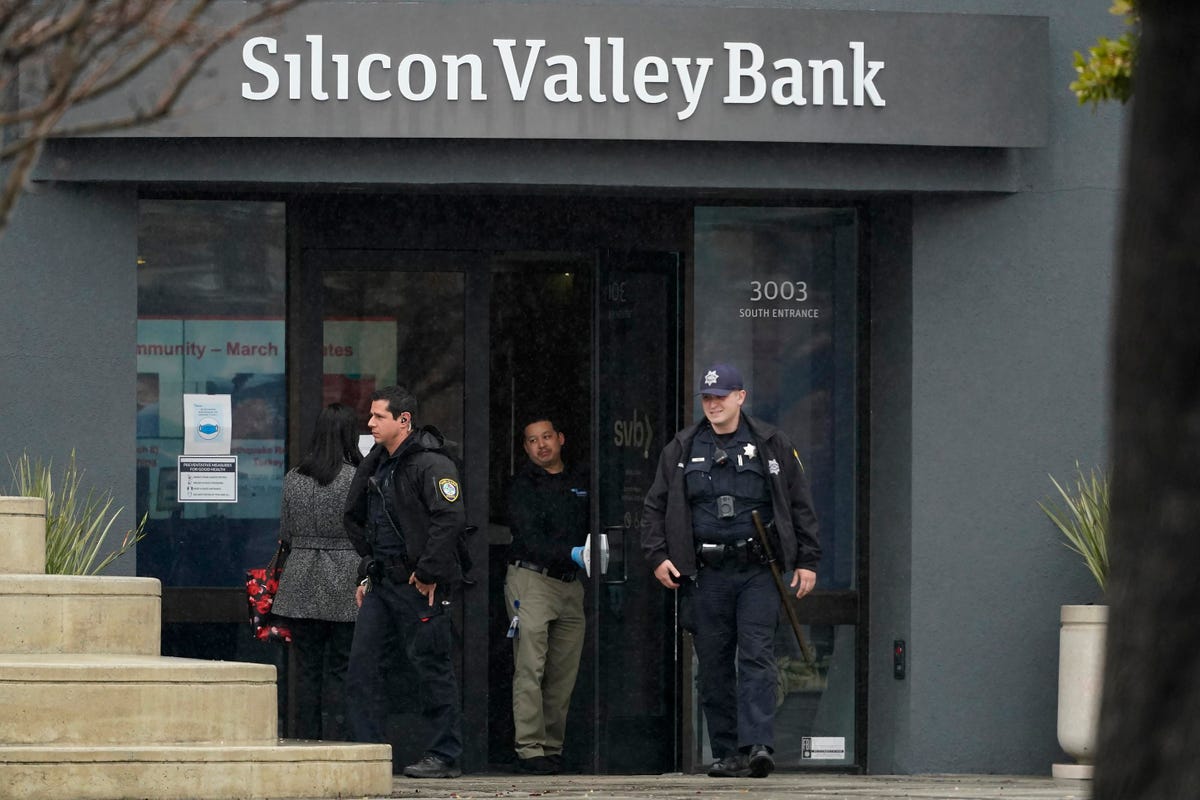The collapsed Silicon Valley Bank (SVB
VB
The failure reminds us subtly of the hidden and unpriced strands of the poly-crisis: unintended consequences of decade-long unorthodox monetary policies, the COVID-19 pandemic remediation measures, the excessive leverage in the system, and the fissures emanating from democracy-eroding rulings.
How could it come to this dismal outcome?
SVB was the 16th largest U.S. bank, with assets of $209bn, of which more than 50% were tied up in long-term securities, coupled with a substantial exposure to the Silicon Valley tech and health startup world. SVB experienced 250% in balance sheet growth between 2019 and 2022.
The bank faced $42 billion in deposit withdrawals on Thursday, March 8 alone. The bank run was the combined outcome of increased cash burn with its startup clients and uncertainty surrounding the bank’s solvency position. SVB had barely 4% in non-interest-bearing deposits and was paying 0.60% more than its peers on its interest-bearing deposits.
In repsonse, SVB sold a $21bn bond portfolio to generate liquidity at a loss of $1.8 billion. Then, on Thursday, March 8, it tried to fill the solvency hole with a combined equity offering of $2.25bn. The attempt failed. FDIC closed the bank on Friday, March 9, at noon.
The bank collapse triggered a slew of questions, especially with respect to the timing and the degree of pro-active attitude of the regulators. Here is a selection allocated under ten cluster questions:
- With more than $8.3 Tr assets remaining on the Fed Reserve bank balance sheet, how will excess liquidity be mopped up without causing further bond price distress and liquidity crunch? Quantitative Easing or ZIRP (Zero interest rate policy) introduced artificially low-interest rates to mitigate the 2008 Financial crisis. These non-traditional monetary policies were continued during the Covid pandemic. When faced with enormous inflation, the Fed reversed the policy drastically. With eight successive interest rate hikes; it imposed a different paradigm. Startup companies saw their IPO prospects deferred and were compelled to withdraw more deposits from their client bank to address cash burn. Higher interest rates also meant unrealized losses for the unhedged bond portfolio. The combination led to a downward spiral in liquidity requirements for SVB. How well is prudential regulatory oversight equipped to calibrate and correctly steer the remaining underlying risks in the system?
- When will anti-trust regulatory bodies cooperate with Central Bank monetary policy to tackle inflation in earnest? Inflation can’t be tackled by interest rate hikes alone. The interest rate transmission mechanism is currently considerably flawed and inadequate. It must be smartly complemented with anti-trust regulatory action aimed at dominant market and sector positions to thwart excessive price-setting prowess. It will also trigger burden sharing in the interest rate market. To what extent Is the Citizen United Supreme Court ruling triggering reluctance to take appropriate regulatory action in these instances?
- Why did the FDIC fail to take proactive measures at the end of Q4 in 2022, when the SVB’s Common Equity Tier 1, a measure of the bank’s capital strength, was virtually wiped out when adjusted for unrealized losses of its securities portfolio? The unrealized losses from its Hold to Maturity banking book stood at $17 bn.
- Why did the FDIC allow SVB to park $91 bn of its deposits in long-dated securities (mortgage bonds and treasuries) without commensurate asset liability management measures (apparently, there was no use (at scale) of interest rate derivatives to reduce the duration exposure along with appropriate convexity management, especially embedded within mortgage-backed securities)?
- Why did the FDIC not intervene at the end of 2021 when SVB disclosed that 96% of their deposits were not covered by FDIC insurance (most were more than $250,000)? Such high reliance on corporate/V.C. funding, with Ripple alone having deposits of up to $3.3 billion, is genuinely uncommon.
- Who oversaw the emergency recapitalization efforts and their sequence on March 8 and 9? Why was almost all of its Available for Sale (AFS) securities portfolio of $21 billion allowed to be sold in the market, triggering the $1.8bn hole in the capital position? Why was that portfolio not repo-ed through the San Francisco Fed discount window until the $2.5 bn capital increase was completed?
- Several insider trading reports were filed, reflecting securities transactions undertaken by key C-suite executives since the beginning of the year. Why was no blackout period instigated until the institution was back on a solid liquidity and solvency footing? Will regulators review the arms’ length nature of those transactions?
- SVB was the 16th largest bank in the U.S., yet the stricter Basel liquidity and solvency rules didn’t apply to them. Do regulatory provisions regarding solvency and prudential liquidity management for regional banks need to be revisited or enhanced? In 2015 SVB benefited from a triumphant rebuke against more stringent solvency and prudential liquidity measures. In a hearing before the Senate Banking Committee, CEO Becker submitted a written statement that the applicable threshold of $50 billion in assets, before more stringent (liquidity and solvency) provisions kick in, was too low. The then-set threshold was moved up to $250 billion. All along, SVB operatedly cunningly underneath that threshold.
- Where were the rating agencies on this fallout? On Wednesday, March 8, 2023, Moody’s still assigned an A3 rating to SVB Financial. This was a reputable rating, more than three grades into investment grade. Later that day, after SVB announced a $1.8bn loss on the sale of its bond portfolio, Moody’s barely nudged SVB’s rating by one tiny notch, to Baa1—still a formidable investment grade rating. Two days later the bank was taken over by FDIC regulators. S&P outdid Moody’s. On March 9, S&P still assigned SVB a BBB-, only to downgrade the company the next day, the day of the bank’s closure, by ten notches to D (or default). What review will the “Office of Credit Ratings” at the SEC initiate to enhance investor protection? What measures will be used against the rating agencies?
- The FDIC declared banks under their remit had $620 bn in non-realized losses at the end of 2022. With more than $16.5 trillion in household debt (mortgage loans, car loans and credit card debt combined), exposed to eight consecutive rate hikes since the Federal reserve decided to address inflation, what is the potential domino effect of this event if credit risk is comingled with interest rate risk? What will SVB fallout mean for the tech start-up world, Silicon Valley, smaller regional banks, California state, and the U.S. economy?
- Who will be the acquirer of SVB? Can it be a foreign entity? Will it add to further banking concentration and loss of much-needed broader diversification?
The resolve and resolutions in weeks to come will determine whether these fault lines, accentuated under the poly-crisis, will be magnified or narrowed or whether the resilience of the U.S. financial system will be weakened or strengthened.
These are just three strands of the poly-crisis rearing their head.
Read the full article here










